November 22, 2024 · 13 min read
Optimizing Task Delegation in Committees with Meeting Analytics

Shaimaa Badawi
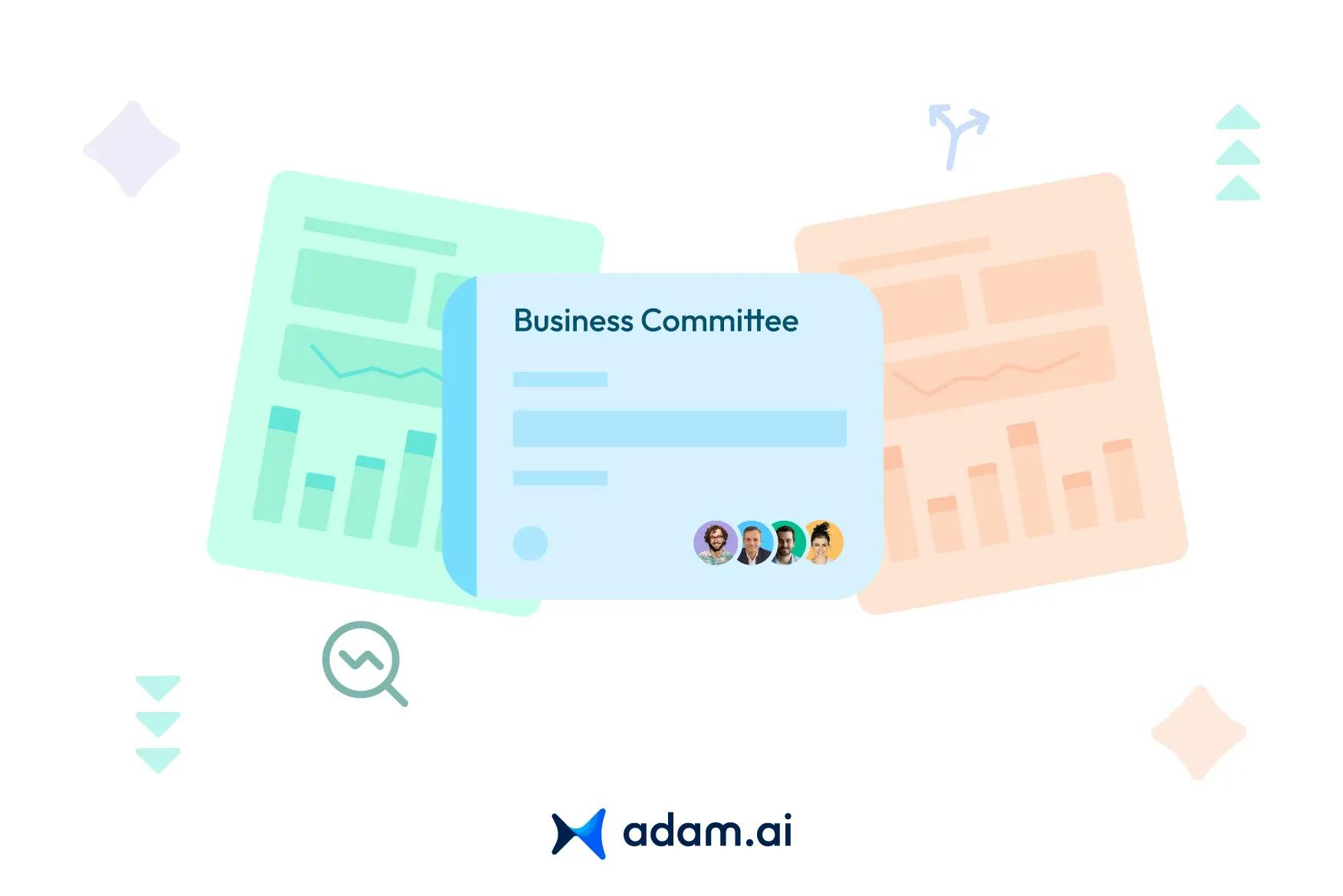
Effective task delegation is the secret ingredient for committee success. Yet, without the right processes, even the best committees can struggle with accountability, missed deadlines, and miscommunication. This article explores how meeting analytics can revolutionize task delegation, ensure transparency, and drive committees toward achieving their goals effortlessly. Dive into best practices, critical metrics to track, and the industries already benefiting from these insights.
What are the common challenges committees face with task delegation?
Task delegation within committees can often feel like navigating a maze. While committees are meant to streamline decision-making and drive progress, certain challenges frequently arise:
- Unclear roles and responsibilities
One of the most common issues is ambiguity around who is responsible for what. Without clear definitions of roles, tasks can fall through the cracks, leading to delays and frustration. - Lack of accountability
Even when tasks are assigned, committees sometimes struggle to hold members accountable. This lack of follow-up can result in incomplete work or missed deadlines. - Inefficient communication
Poor communication within committees often leads to misunderstandings, duplicated efforts, or incomplete tasks. This can stem from unstructured meetings or failure to track decisions effectively. - Unequal workload distribution
Delegating tasks fairly is another challenge. Some members may be overburdened while others contribute minimally, leading to resentment or burnout. - Absence of tracking mechanisms
Without tools to monitor progress, committees may lose visibility on task completion, hindering their ability to meet objectives on time. - External dependencies
Tasks that rely on inputs or approvals from other teams or departments can face delays, derailing the committee’s workflow.
Why is effective task delegation critical for committee success?
Effective task delegation is the backbone of a committee’s ability to achieve its objectives. When done correctly, delegation fosters productivity, collaboration, and accountability, ensuring the committee operates like a well-oiled machine. Here’s why it’s indispensable:
- Promotes clarity and focus
Delegating tasks with clear instructions eliminates confusion and ensures every member knows their role. This clarity enables committees to focus on strategic goals rather than revisiting the basics. - Maximizes team efficiency
By assigning tasks to individuals best suited for them based on expertise, committees can harness the full potential of their members. This ensures time and resources are utilized effectively. - Encourages accountability
When responsibilities are explicitly assigned, members take ownership of their tasks, leading to more reliable and timely execution. Accountability keeps everyone motivated to deliver their best. - Fosters collaboration and trust
Delegation involves shared responsibilities, which encourages members to rely on and trust one another. This teamwork strengthens the committee's ability to tackle challenges collectively. - Facilitates strategic decision-making
With tasks appropriately delegated, the committee can prioritize high-level decisions without getting bogged down in operational details, enabling it to focus on long-term goals. - Ensures continuity and adaptability
Effective delegation creates a system where work doesn’t stop if one member is unavailable. Tasks can easily be redistributed, ensuring continuity in the committee’s efforts.
What is meeting analytics, and how does it support committee task management?
Meeting analytics refers to the systematic collection and analysis of data generated during meetings, such as attendance, task assignments, decision-making timelines, and action item progress. By transforming meeting data into actionable insights, committees can better manage tasks and enhance their overall effectiveness.
Here’s how meeting analytics supports committee task management:
- Tracking task assignments
Meeting analytics provides a clear record of who was assigned which tasks, along with deadlines and dependencies. This ensures transparency and minimizes the risk of miscommunication. - Monitoring progress in real-time
Analytics dashboards allow committees to see which tasks are on track and which are falling behind. This enables timely interventions to address bottlenecks or reassign responsibilities. - Improving accountability
With detailed analytics, committees can evaluate individual and collective performance. Metrics like completion rates and response times highlight areas for improvement, fostering a culture of accountability. - Streamlining follow-ups
Insights from meeting analytics help committees keep track of pending tasks and follow up efficiently. Automated reminders and status updates ensure no action item slips through the cracks. - Identifying inefficiencies
Analytics can pinpoint recurring challenges, such as delays caused by unclear decisions or lack of participation. This data allows committees to refine their processes and improve productivity. - Enhancing decision-making
By visualizing trends and outcomes from past meetings, committees can make data-driven decisions. For example, knowing which tasks were completed on time and which faced hurdles helps improve future planning. - Optimizing resource allocation
Meeting analytics highlights where committee resources, time, expertise, or effort, are being spent, helping prioritize critical tasks and avoid unnecessary workload.
What key metrics should committees track with meeting analytics?
Meeting analytics empowers committees by providing data-driven insights that improve task management, collaboration, and decision-making. Tracking the right metrics is essential for optimizing committee performance and achieving strategic goals. Here are the key metrics committees should monitor:
1. Task completion rate
- What it tracks: The percentage of assigned tasks completed within the set deadline.
- Why it matters: This metric reveals the committee’s overall productivity and highlights members or teams consistently delivering results or falling behind.
2. Action item progress
- What it tracks: The status of action items (e.g., completed, in progress, or overdue) assigned during meetings.
- Why it matters: Monitoring progress ensures that no task is overlooked and helps committees prioritize pending items.
3. Attendance and participation
- What it tracks: Attendance rates and participation levels during meetings.
- Why it matters: This metric identifies who is consistently present and engaged, ensuring balanced input from all members while addressing absenteeism or lack of participation.
4. Decision-making efficiency
- What it tracks: The time spent reaching key decisions and the number of actionable outcomes per meeting.
- Why it matters: Efficient decision-making keeps meetings productive and ensures the committee stays focused on priorities.
5. Follow-up rate
- What it tracks: The percentage of follow-ups completed after meetings.
- Why it matters: Follow-up actions are critical for translating discussions into results. This metric ensures accountability and momentum between meetings.
6. Time allocation per agenda item
- What it tracks: The amount of time spent discussing each agenda item.
- Why it matters: Time allocation metrics help committees identify inefficiencies, such as over-discussing minor topics or rushing critical issues, and adjust future agendas accordingly.
7. Task reassignment frequency
- What it tracks: The number of tasks reassigned due to delays, incomplete work, or unavailability.
- Why it matters: Frequent reassignments indicate workflow bottlenecks or imbalanced task distribution.
8. Consensus rate
- What it tracks: The percentage of agenda items resolved with unanimous or majority agreement.
- Why it matters: This metric gauges the committee’s ability to collaborate effectively and make decisions that align with organizational goals.
9. Recurring issues or bottlenecks
- What it tracks: Tasks or decisions that appear repeatedly due to unresolved issues.
- Why it matters: Identifying recurring problems helps committees address root causes and improve long-term efficiency.
10. Task prioritization accuracy
- What it tracks: The correlation between prioritized tasks and their timely completion.
- Why it matters: Ensures that the committee is focusing on high-impact work rather than spending resources on less critical tasks.
How do data insights from meeting analytics prevent bottlenecks in committee workflows?
Meeting analytics serves as a proactive tool to identify, address, and ultimately prevent bottlenecks in committee workflows. By leveraging data insights, committees can streamline their operations and maintain steady progress toward their goals. Here’s how:
1. Identifying delays early
Meeting analytics highlights overdue tasks, incomplete action items, and missed deadlines. By flagging these issues in real-time, committees can intervene promptly to redistribute workloads, adjust deadlines, or provide additional support to struggling members.
2. Improving resource allocation
Data insights reveal if specific members or teams are consistently overburdened, while others have capacity. This allows committees to balance workloads more effectively, ensuring no one is overwhelmed and that tasks are completed efficiently.
3. Enhancing role clarity
Analytics data pinpoints areas where task ownership may be unclear or where responsibilities overlap. Addressing these ambiguities helps eliminate delays caused by confusion, ensuring each task has a clear owner and purpose.
4. Tracking progress in real-time
Dashboards and progress trackers provide a snapshot of ongoing tasks and their statuses. This visibility allows committees to anticipate potential bottlenecks, such as dependencies on other tasks or delays in decision-making, and resolve them before they escalate.
5. Pinpointing recurring issues
Meeting analytics can identify patterns in workflow disruptions, such as repeated delays in a particular phase or with specific members. Recognizing these trends enables committees to address systemic problems, like ineffective processes or insufficient training.
6. Streamlining decision-making
Data on time allocation and discussion points helps committees identify inefficiencies in how decisions are made. For example, if certain agenda items consistently take too long, adjustments can be made to streamline the process and avoid dragging out subsequent tasks.
7. Automating follow-ups
Automated reminders for upcoming deadlines or overdue action items ensure that follow-ups happen without requiring manual oversight. This reduces the risk of forgotten tasks, which often lead to bottlenecks in workflows.
8. Enhancing communication flow
Meeting analytics tracks communication patterns, revealing gaps where information may not be reaching all relevant stakeholders. Addressing these gaps ensures that everyone is informed and equipped to move tasks forward without unnecessary delays.
9. Prioritizing critical tasks
Data-driven prioritization ensures that high-impact tasks are addressed first. Committees can focus their energy on resolving pressing issues, avoiding bottlenecks caused by spending too much time on less critical work.
10. Encouraging accountability
By making individual and team contributions visible, meeting analytics fosters accountability. Members are more likely to complete their tasks on time, knowing their progress is being monitored and shared.
Example impact:
Consider a committee managing a project with interdependent tasks. Meeting analytics can reveal that Task A is delayed, which directly affects Task B. By identifying this bottleneck early, the committee can reassign Task A or allocate additional resources to get it back on track, preventing a chain reaction of delays.
What are the best practices for delegating tasks in a committee setting?
Effective task delegation within a committee ensures that responsibilities are distributed equitably, progress is measurable, and objectives are met. Here are some best practices to streamline the delegation process and maximize efficiency:
1. Define roles and responsibilities clearly
- Assign tasks based on each member's expertise, availability, and interest.
- Ensure every task has a clear owner to avoid duplication or neglect.
- Provide detailed instructions and expectations to eliminate ambiguity.
2. Prioritize tasks according to objectives
- Align tasks with the committee’s overall goals and strategic priorities.
- Tackle high-impact or time-sensitive tasks first to maintain momentum.
- Use meeting analytics to identify recurring priorities or roadblocks.
3. Set realistic deadlines
- Ensure timelines are achievable, considering the complexity of the task and members’ other commitments.
- Factor in dependencies, such as approvals or resources needed from others.
- Use progress trackers to monitor deadlines and adjust as needed.
4. Utilize members’ strengths
- Assign tasks based on individual strengths and skillsets to optimize outcomes.
- Rotate responsibilities periodically to build diverse skills within the committee.
- Leverage tools like a skills matrix to match tasks to the right members.
5. Communicate expectations upfront
- Provide a comprehensive overview of the task, its purpose, and desired outcomes.
- Clarify how the task fits into the committee’s broader mission.
- Use shared platforms to centralize instructions, updates, and feedback.
6. Monitor progress and provide feedback
- Schedule regular check-ins to review task status and address challenges.
- Use meeting analytics to track task completion rates and identify potential delays.
- Provide constructive feedback and recognize accomplishments to boost motivation.
7. Foster accountability
- Make task assignments visible to all committee members to encourage peer accountability.
- Document responsibilities and progress during meetings for transparency.
- Follow up consistently to ensure deadlines are respected.
8. Empower members with resources and support
- Equip members with the tools and information they need to succeed.
- Encourage collaboration by connecting members who may need to work together.
- Offer guidance without micromanaging, fostering independence and trust.
9. Automate where possible
- Use meeting management tools to automate reminders, follow-ups, and status updates.
- Streamline repetitive processes, like progress reporting or documentation.
10. Review and reflect regularly
- Analyze the delegation process periodically to identify improvements.
- Solicit feedback from members about what worked and what didn’t.
- Adjust strategies to better align with the committee’s evolving needs.
Example in action:
A healthcare committee tasked with improving patient care may assign one member to research current practices, another to analyze patient data, and a third to liaise with external stakeholders. Using clear deadlines, progress tracking tools, and regular check-ins ensures tasks are completed efficiently, fostering collaboration and achieving objectives.
What industries benefit most from meeting analytics in committee management?
Meeting analytics has transformative potential across various industries, particularly those reliant on committees to drive decisions, monitor progress, and ensure accountability. Here’s a closer look at industries that reap the most benefits:
1. Healthcare
- Why it benefits:
Healthcare organizations frequently rely on committees for clinical oversight, compliance, patient safety, and administrative decision-making. Meeting analytics ensures tasks like policy reviews or compliance checks are completed on time and tracked effectively. - Example use:
A hospital’s quality assurance committee can track metrics such as the implementation rates of new protocols or the resolution time for patient safety concerns.
2. Education
- Why it benefits:
Schools, colleges, and universities use committees for curriculum design, accreditation, resource allocation, and student success initiatives. Meeting analytics enhances transparency in decisions and ensures alignment with institutional goals. - Example use:
A university’s accreditation committee can track progress on action items related to maintaining accreditation standards and deadlines.
3. Finance
- Why it benefits:
Financial institutions rely on committees for risk management, compliance, audits, and strategic planning. Meeting analytics ensures clear documentation of decisions and enhances accountability in regulatory matters. - Example use:
A risk committee at a bank can use analytics to monitor the timely execution of action plans tied to regulatory compliance or risk mitigation strategies.
4. Government and public administration
- Why it benefits:
Government bodies and agencies handle complex agendas involving multiple stakeholders, from policymaking to project oversight. Meeting analytics supports task management, budget tracking, and policy implementation. - Example use:
A city council’s infrastructure committee can use analytics to track progress on development projects and measure public feedback on initiatives.
5. Nonprofits
- Why it benefits:
Nonprofits manage committees for fundraising, community programs, and governance. Meeting analytics helps track donor outreach efforts, program progress, and resource allocation. - Example use:
A nonprofit’s fundraising committee can track the effectiveness of campaigns, ensuring donor outreach and funding goals are achieved.
6. IT and technology
- Why it benefits:
Tech companies rely on committees for product development, project management, and innovation strategy. Meeting analytics improves task tracking and helps maintain alignment with fast-evolving business goals. - Example use:
A product development committee can track task dependencies and monitor progress toward milestones in agile workflows.
7. Energy and utilities
- Why it benefits:
Committees in this sector focus on compliance, sustainability, and large-scale project management. Meeting analytics ensures decisions are data-driven and timelines are met. - Example use:
An energy company’s sustainability committee can track progress on renewable energy initiatives and compliance with environmental regulations.
8. Pharmaceuticals and life sciences
- Why it benefits:
These industries rely on committees for research oversight, regulatory compliance, and product approvals. Meeting analytics ensures rigorous tracking of tasks and adherence to strict deadlines. - Example use:
A clinical trial oversight committee can use analytics to monitor trial milestones, regulatory compliance, and data quality.
9. Manufacturing and supply chain
- Why it benefits:
Committees in manufacturing focus on process improvement, quality control, and supply chain optimization. Meeting analytics enhances tracking and communication across complex supply chains. - Example use:
A quality assurance committee can track corrective actions related to production defects and ensure timely resolution.
10. Retail and e-commerce
- Why it benefits:
Retailers use committees for strategy development, customer experience initiatives, and logistics management. Meeting analytics helps monitor tasks related to campaigns, inventory, or customer satisfaction. - Example use:
A marketing committee can track the rollout of promotional campaigns and analyze engagement metrics in real-time.
How can adam.ai transform task delegation and accountability in committees?
adam.ai enhances task delegation and accountability in committees with features tailored to streamline workflows and provide actionable meeting analytics. Here’s how:
1. Agenda management
adam.ai’s agenda builder organizes discussions by assigning speakers, attaching documents, and setting time limits. This ensures every agenda item is actionable and linked to specific responsibilities.
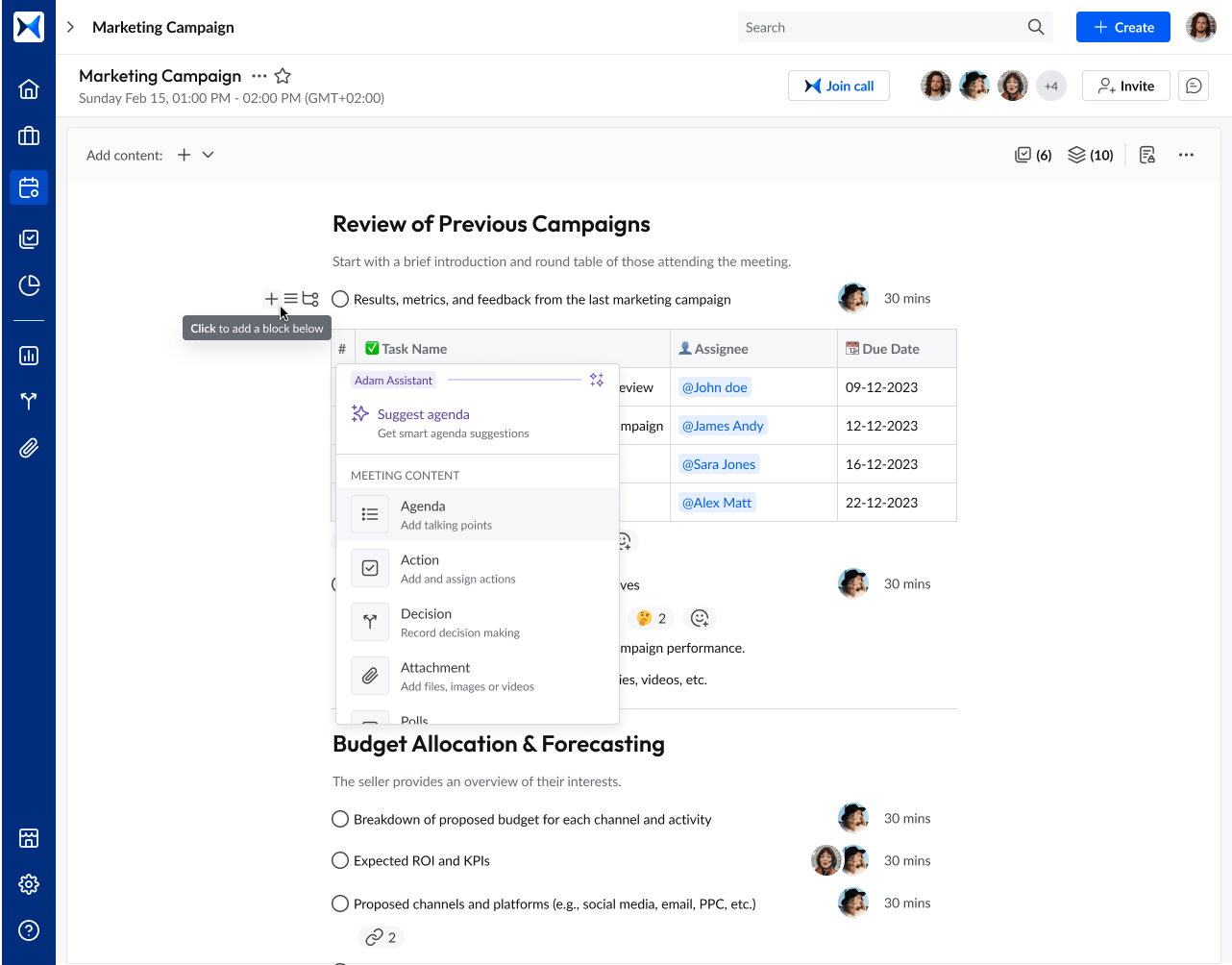
2. Content collaboration
Centralized content management allows members to attach reports, tag individuals, and comment in real time. This fosters seamless communication and reduces delays.
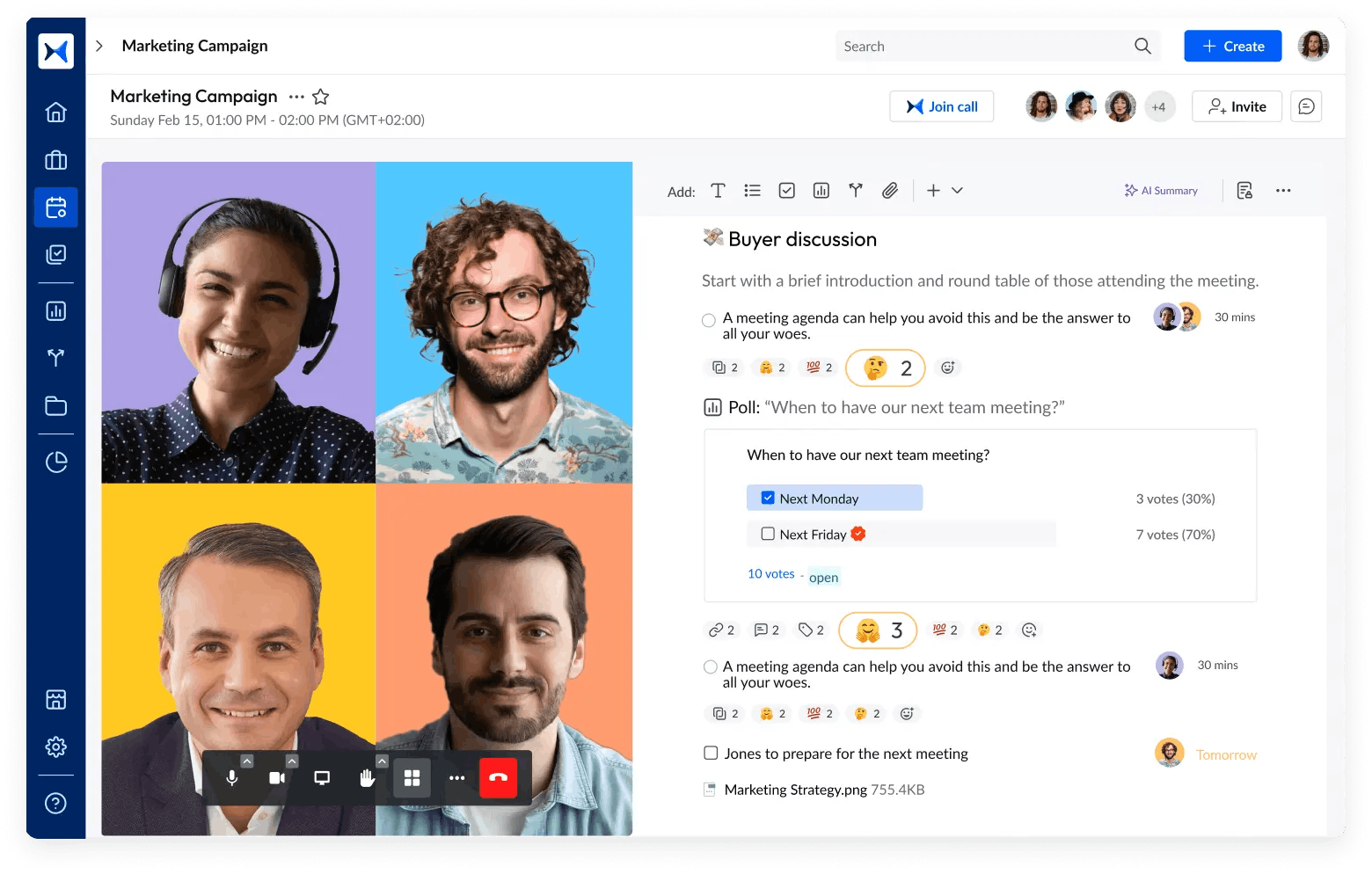
3. Action tracking
Tasks can be assigned directly in adam.ai with clear deadlines and owners. Automated reminders and progress updates ensure accountability and timely completion.
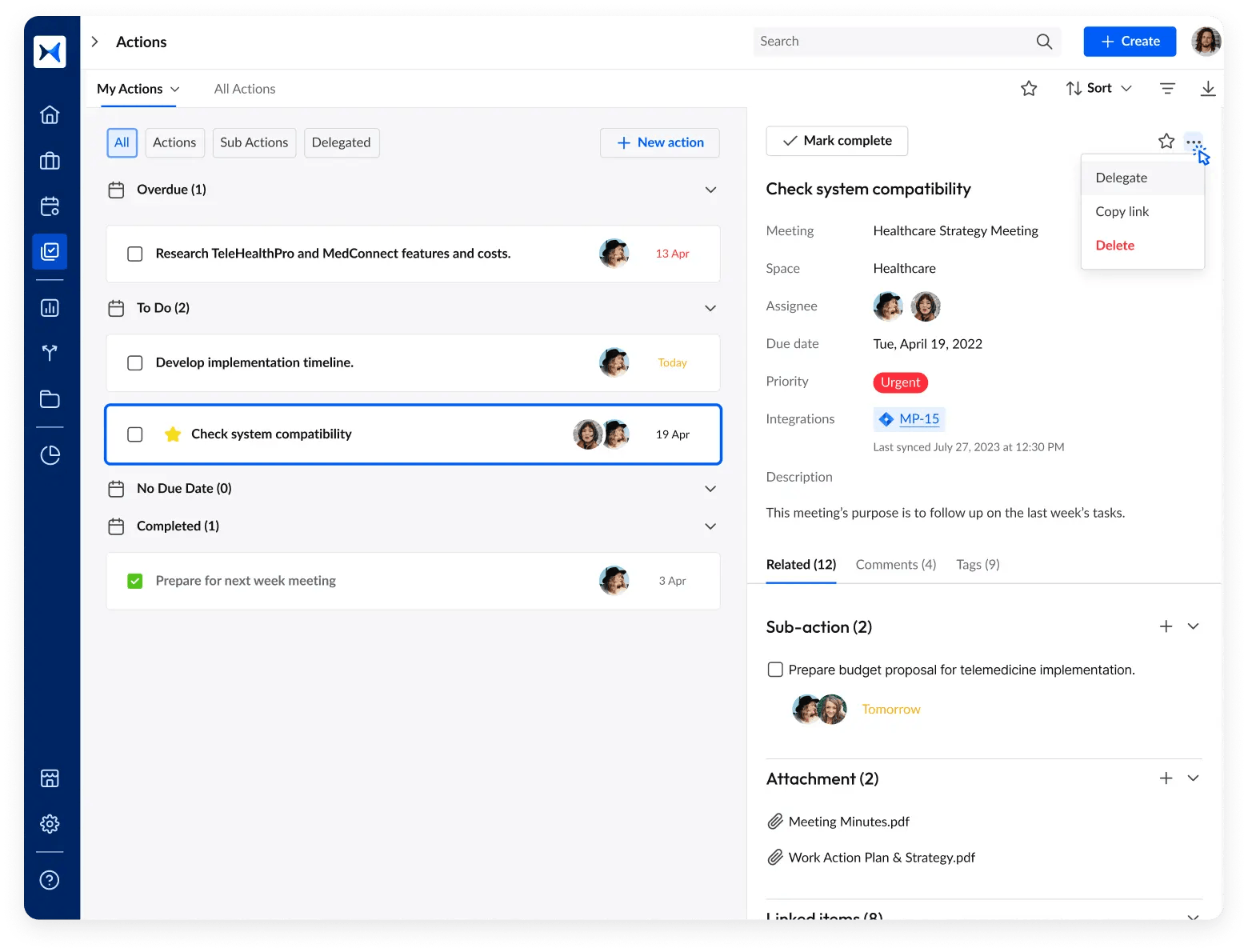
4. Polling for decisions
Integrated polling simplifies decision-making by capturing votes in real time, ensuring inclusive and efficient consensus-building.
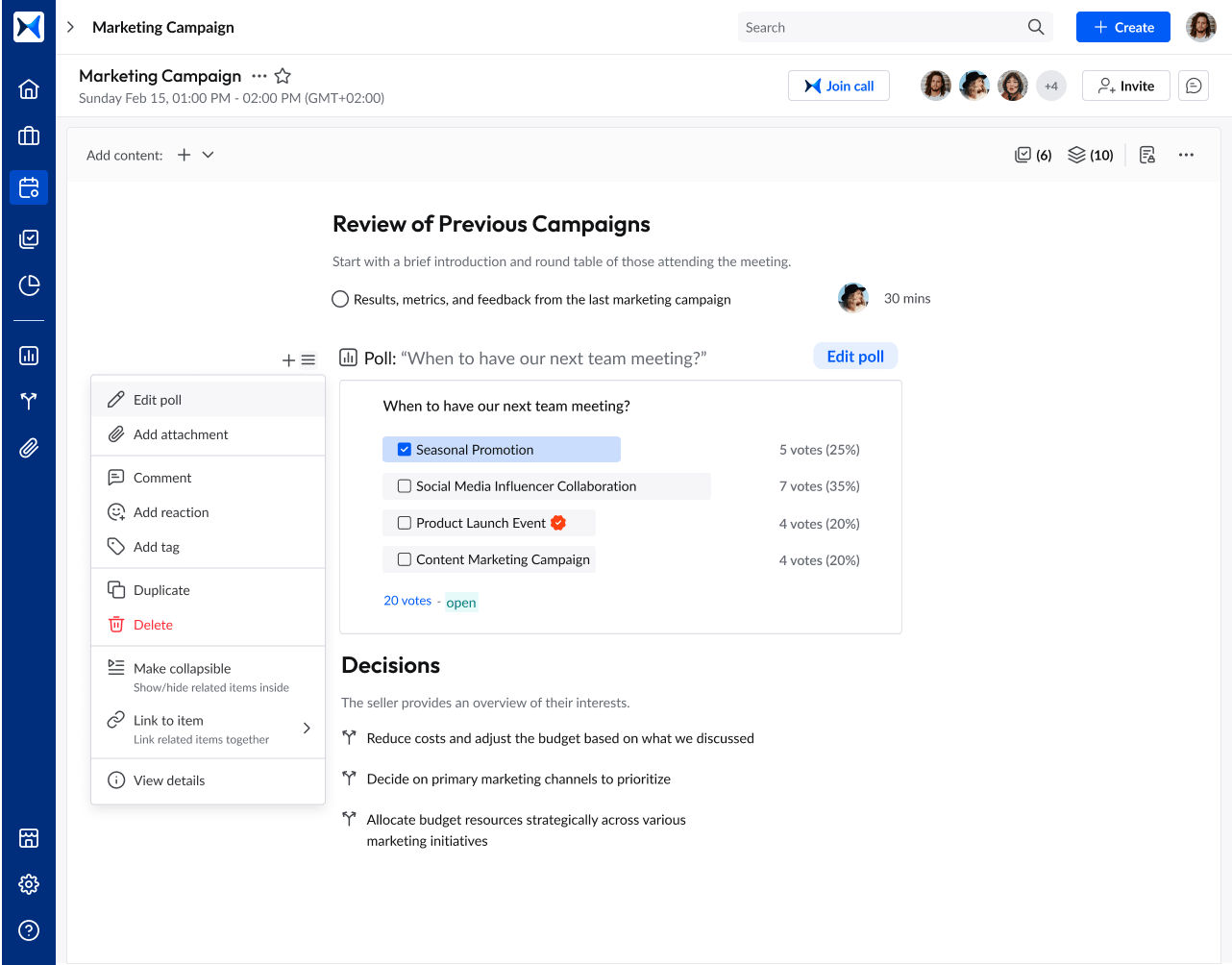
5. Meeting minutes
adam.ai automatically generates meeting minutes, documenting task assignments and decisions. This creates a clear follow-up plan and ensures nothing is overlooked.
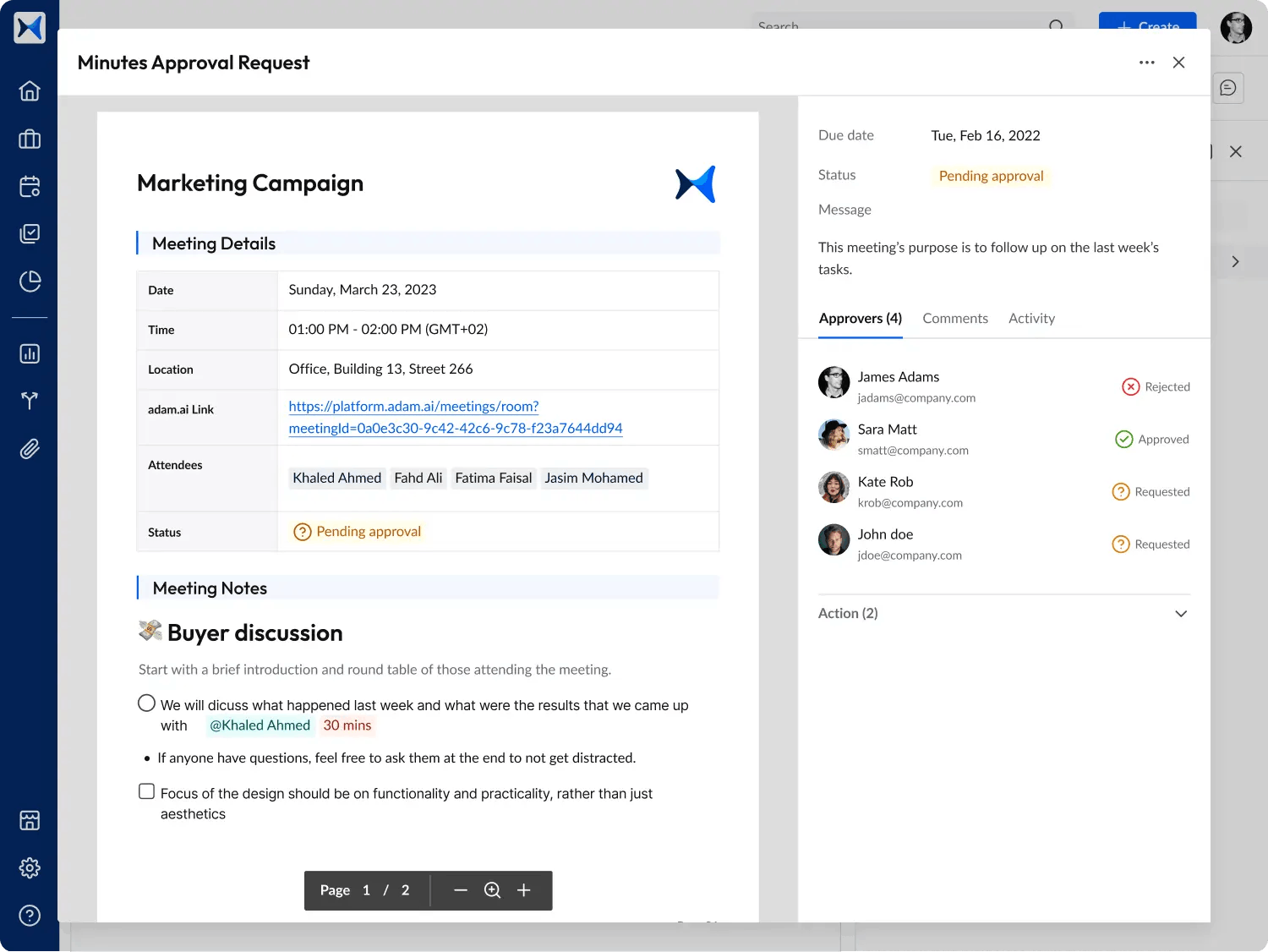
6. Analytical dashboard
Real-time analytics provide insights into task progress, attendance, and decision timelines. Committees can identify bottlenecks and refine their workflows.
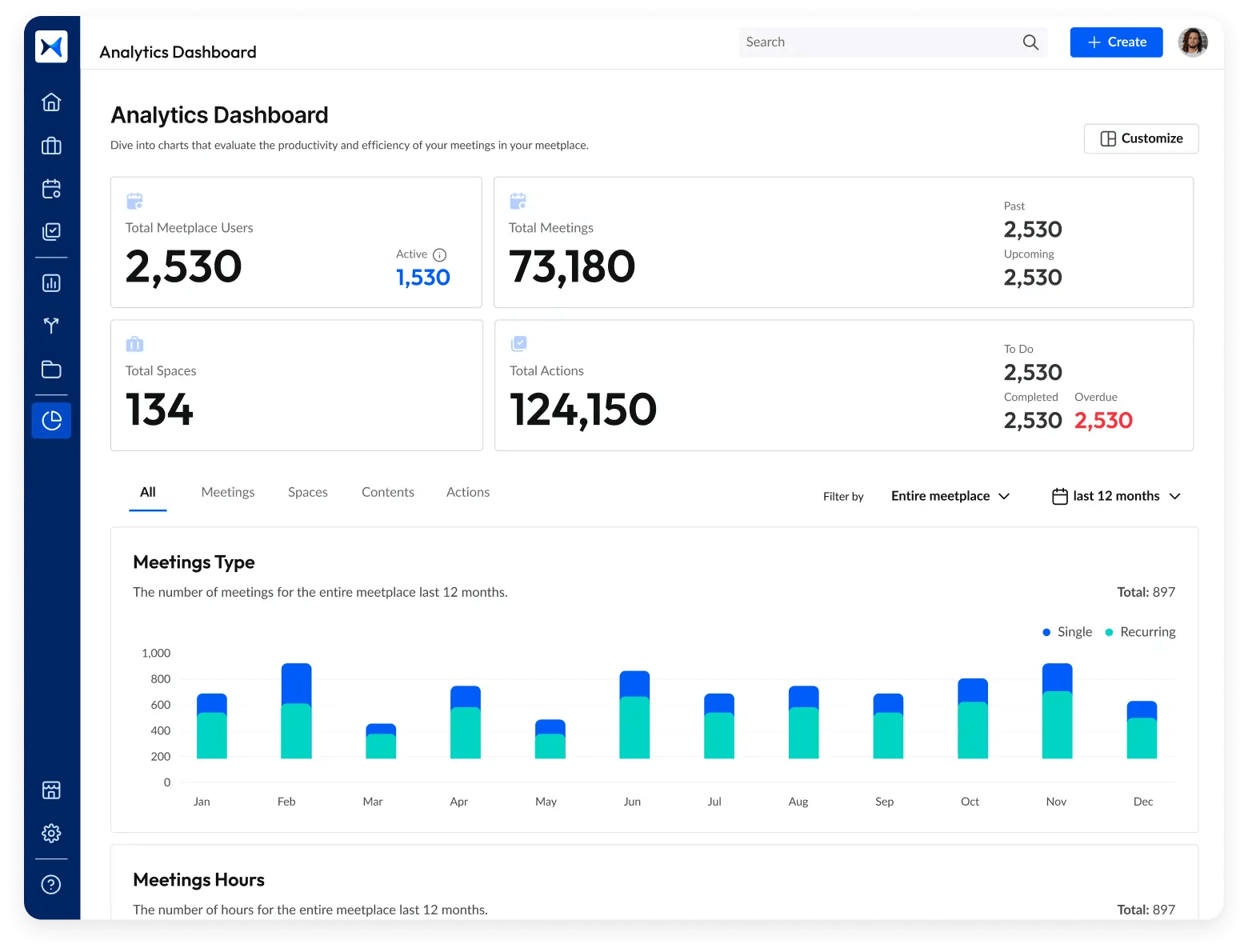
Transform how you conduct critical meetings—From meticulous preparation to effective execution and insightful follow-up, adam.ai integrates comprehensive analytics, full customization, and intuitive interfaces with powerful meeting management tools.
Easy onboarding. Enterprise-grade security. 24/7 dedicated support.
The bottom line
Streamlining task delegation and ensuring accountability doesn’t have to be a challenge. By leveraging actionable data and modern tools, committees can transform their workflows, make better decisions, and achieve measurable success with every meeting.
And while there may be multiple solutions available, here is why adam.ai is the meeting management software platform you can trust:
- adam.ai is one of Atlassian Ventures' portfolio companies.
- In the meeting management software category on G2, adam.ai has been ranked a leader and a high performer for successive quarters in the past years.
- adam.ai has been included in the Forrester Report in the AI-enabled meeting technology landscape.
- adam.ai is trusted and used by powerful teams and organizations worldwide for all types of critical meetings, like board, committee, project management, and business development meetings.
- And most importantly, adam.ai integrates with your existing workflow, is SOC2 compliant, provides dedicated support and success, and has a free trial option.
Subscribe to adam.ai blog
Stay ahead with the latest insights—get our newest blog posts, tips, and updates sent straight to your inbox.